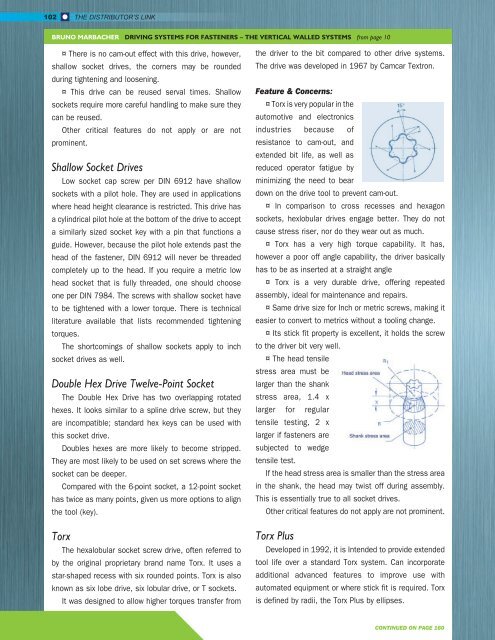FALL 2021
Distributor's Link Magazine Fall 2021 / Vol 44 No 4
Distributor's Link Magazine Fall 2021 / Vol 44 No 4
Create successful ePaper yourself
Turn your PDF publications into a flip-book with our unique Google optimized e-Paper software.
102<br />
THE DISTRIBUTOR’S LINK<br />
BRUNO MARBACHER DRIVING SYSTEMS FOR FASTENERS – THE VERTICAL WALLED SYSTEMS from page 10<br />
¤ There is no cam-out effect with this drive, however,<br />
shallow socket drives, the corners may be rounded<br />
during tightening and loosening.<br />
¤ This drive can be reused serval times. Shallow<br />
sockets require more careful handling to make sure they<br />
can be reused.<br />
Other critical features do not apply or are not<br />
prominent.<br />
Shallow Socket Drives<br />
Low socket cap screw per DIN 6912 have shallow<br />
sockets with a pilot hole. They are used in applications<br />
where head height clearance is restricted. This drive has<br />
a cylindrical pilot hole at the bottom of the drive to accept<br />
a similarly sized socket key with a pin that functions a<br />
guide. However, because the pilot hole extends past the<br />
head of the fastener, DIN 6912 will never be threaded<br />
completely up to the head. If you require a metric low<br />
head socket that is fully threaded, one should choose<br />
one per DIN 7984. The screws with shallow socket have<br />
to be tightened with a lower torque. There is technical<br />
literature available that lists recommended tightening<br />
torques.<br />
The shortcomings of shallow sockets apply to inch<br />
socket drives as well.<br />
Double Hex Drive Twelve-Point Socket<br />
The Double Hex Drive has two overlapping rotated<br />
hexes. It looks similar to a spline drive screw, but they<br />
are incompatible; standard hex keys can be used with<br />
this socket drive.<br />
Doubles hexes are more likely to become stripped.<br />
They are most likely to be used on set screws where the<br />
socket can be deeper.<br />
Compared with the 6-point socket, a 12-point socket<br />
has twice as many points, given us more options to align<br />
the tool (key).<br />
Torx<br />
The hexalobular socket screw drive, often referred to<br />
by the original proprietary brand name Torx. It uses a<br />
star-shaped recess with six rounded points. Torx is also<br />
known as six lobe drive, six lobular drive, or T sockets.<br />
It was designed to allow higher torques transfer from<br />
the driver to the bit compared to other drive systems.<br />
The drive was developed in 1967 by Camcar Textron.<br />
Feature & Concerns:<br />
¤ Torx is very popular in the<br />
automotive and electronics<br />
industries because of<br />
resistance to cam-out, and<br />
extended bit life, as well as<br />
reduced operator fatigue by<br />
minimizing the need to bear<br />
down on the drive tool to prevent cam-out.<br />
¤ In comparison to cross recesses and hexagon<br />
sockets, hexlobular drives engage better. They do not<br />
cause stress riser, nor do they wear out as much.<br />
¤ Torx has a very high torque capability. It has,<br />
however a poor off angle capability, the driver basically<br />
has to be as inserted at a straight angle<br />
¤ Torx is a very durable drive, offering repeated<br />
assembly, ideal for maintenance and repairs.<br />
¤ Same drive size for Inch or metric screws, making it<br />
easier to convert to metrics without a tooling change.<br />
¤ Its stick fit property is excellent, it holds the screw<br />
to the driver bit very well.<br />
¤ The head tensile<br />
stress area must be<br />
larger than the shank<br />
stress area, 1.4 x<br />
larger for regular<br />
tensile testing, 2 x<br />
larger if fasteners are<br />
subjected to wedge<br />
tensile test.<br />
If the head stress area is smaller than the stress area<br />
in the shank, the head may twist off during assembly.<br />
This is essentially true to all socket drives.<br />
Other critical features do not apply are not prominent.<br />
Torx Plus<br />
Developed in 1992, it is Intended to provide extended<br />
tool life over a standard Torx system. Can incorporate<br />
additional advanced features to improve use with<br />
automated equipment or where stick fit is required. Torx<br />
is defined by radii, the Torx Plus by ellipses.<br />
CONTINUED ON PAGE 160
















